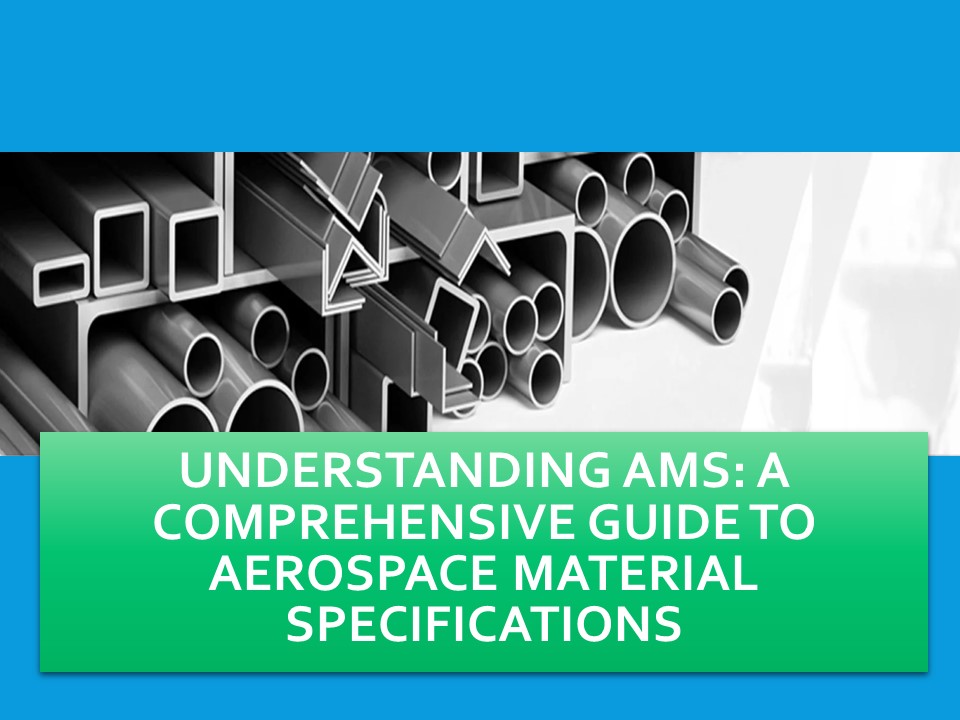Understanding AMS: A Comprehensive Guide to Aerospace Material Specifications PowerPoint PPT Presentation
Title: Understanding AMS: A Comprehensive Guide to Aerospace Material Specifications
1
Understanding AMS A Comprehensive Guide to
Aerospace Material Specifications
2
Table of Content
- Introduction
- What is AMS?
- Why does AMS matter?
- How does AMS work?
- Advancements in Aerospace Materials
- The Role of AMS in Advancements
- The Future of AMS
- Conclusion
3
Introduction
- When it comes to aerospace, top-notch performance
and safety are paramount. That's why materials
used in aerospace applications must adhere to
standards set by Aerospace Material
Specifications (AMS). Developed by SAE
International, AMS is an extensive resource for
ensuring these materials meet strict guidelines.
In this guide, we'll learn what AMS is, why it's
so important, and how it works.
4
What is AMS?
- The aerospace industry mandates that all
materials used, from metals to polymers and
composites, must meet certain requirements. To
ensure these specifications are met, AMS
standards have been established. These cover
various types of materials such as aluminum,
titanium, steel and nickel-based elements. The
parameters of the guidelines include not only
chemical composition but also mechanical
properties and manufacturing processes for each
material. Thus AMS standards guarantee the
necessary quality for use in the aerospace sector.
5
Why does AMS matter?
- The aerospace industry relies on AMS standards
for the success and protection of the public. No
matter how extreme the conditions are whether
it's temperature, pressure, or stress materials
used in aerospace applications must remain sturdy
and dependable. A breakage in a single element
could be devastating, thus it's essential that
any components employed in this sector abide by
stringent criteria of quality and
trustworthiness. Fortunately, AMS standards
guarantee that they do.
6
How does AMS work?
- The SAE International is responsible for the
regular updating of AMS standards, which take
into account both the latest technological
advances and industry requirements. To employ
materials in aerospace applications,
manufacturers must follow these regulations
detailed within a thorough database. Verification
of compliance can only be achieved by undergoing
testing and certification processes to guarantee
that the criteria has been met.
7
Advancements in Aerospace Materials
- In the world of aerospace engineering, a major
point of emphasis is the invention and
optimization of new materials. The purpose of
this is to make them stronger than their
predecessors, as well as lessening their weight.
This is particularly applicable to aircraft
parts with lighter components, there will be
improved gas mileage performance and lesser
emissions being produced. At present, composites
such as carbon fiber are allowing for structures
that boast an optimal balance between strength
and lightness. Additionally, 3D printing has also
been employed to fashion complex pieces with
greater accuracy compared to traditional methods.
8
The Role of AMS in Advancements
- The aerospace industry has rigorous requirements
that new materials and processes need to comply
with in order to be used. This is where AMS
standards have a essential function, by outlining
the specifications for components used in
aerospace applications they make sure that fresh
products and procedures are up to the highest
quality and dependability expectations.
Especially so when it comes to parts utilized in
key aspects such like aircraft engines and
landing gear.
9
The Future of AMS
- The aerospace industry's fast-paced development
necessitates reliable standards for materials
utilized in its applications. To meet this
demand, the American Society for Testing and
Materials (AMS) is actively working to refine
existing standards and create new ones that are
better-suited to present technology. A
particularly notable example is the analysis of
graphene, a material praised for its strength and
conductivity that may revolutionize aerospace
engineering.
10
Conclusion
- To sum up, AMS regulations are of utmost
importance to the aerospace sector. Adhering to
these criteria is imperative for guaranteeing
safety and dependability of all aerospace
components. An awareness of AMS and its
significance is essential for manufacturers to
ensure they are utilizing materials which meet
the highest quality and dependability standards.
Compliance with AMS rules is a major element that
contributes towards success of the aerospace
industry.
11
Alloy Metals Company
- Phone
- 562-9411616
- Website
- https//alloymetalsco.com/
- sales_at_alloymetalsco.com/
- Location
- 3400 E 69th St, Long Beach, CA, 90805 USA

